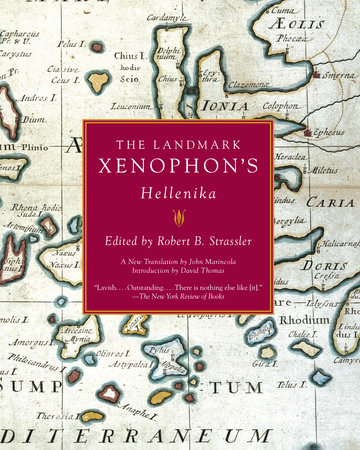Excerpt
The Landmark Xenophon's Anabasis
Darius and Parysatis had two sons, the elder called Artaxerxes, the younger Cyrus. When Darius fell ill and suspected that it was the end of his life, he wanted his two sons, both of them, to be with him. [2] His elder son happened to be with him already, so he sent for Cyrus from the province over which he had made him satrap (he had also appointed him general of all those whose muster point was the plain of Kastolos). Accordingly, Cyrus went up into the interior, taking Tissaphernes with him in the belief that he was a friend, as well as three hundred Greek hoplites, whose commander was Xenias of Parrasia. [3] After Darius died and Artaxerxes succeeded to the kingship, Tissaphernes maligned Cyrus to his brother on the ground that he was plotting against the king. Artaxerxes was persuaded of this and arrested Cyrus, intending to put him to death; but their mother successfully pleaded on his behalf, and so he sent him back again to his province. [4] Departing as he did, dishonored and having been put in great danger, Cyrus set about planning how to avoid ever again being at hisbrother’s mercy, and how instead to become king in his place if he could. indeed, their mother, Parysatis, was on Cyrus’ side, for she loved him rather than Artaxerxes, even though it was Artaxerxes wh was the king. [5] When people came to Cyrus from the king, he used to send them back to the interior having treated them all so well that from then on they were his friends rather than the king’s. In addition, he used to take care that the barbarians at his own court should be fit and ready to wage war and favorably disposed toward him.
[6] He went to work putting together a force of Greeks, but as much as he possibly could, he disguised his purpose so as to surprise a completely unprepared king. So this was how he proceeded to collect them: turning to all the garrisons he had in the cities, he gave instructions to each of the garrison commanders to secure the greatest number and highest quality of men from the Peloponnese that he could, on the ground that Tissaphernes had designs on the cities. the Ionian cities had indeed of old been granted by the king to Tissaphernes, but they had then revolted to Cyrus, all except Miletus; [7] in the case of Miletus, Tissaphernes had realized in advance that the milesians were resolved on the same step, and he had put some of them to death and exiled others. Cyrus took in the exiles, assembled an army, and set about besieging Miletus both by land and by sea in an effort to restore those who had been expelled and this served him as another excuse to gather an army. [8] He sent to the king to say he thought that, as he was the king’s brother, these cities should be given to him rather than be ruled by Tissaphernes, and his mother was in league with him on this. Consequently the king did not perceive the plot against himself but thought that if Cyrus was making war on Tissaphernes, he was running through his money on the expenses of the campaign; and so Artaxerxes was not at all displeased at their fighting one another. this was especially the case as Cyrus continued to send the king the tribute that fell due from the cities that belonged to Tissaphernes but were in fact in Cyrus’ own hands.
[9] Another army was being assembled for Cyrus in the Chersonese on the other side of the strait from Abydosin the following way: Klearchos was a Lacedaemonian exile whom Cyrus had met and admired, and to whom he gave ten thousand darics. Klearchos took the gold and used the money to assemble an army. making the Chersonese his base, he proceeded to wage war on the Thracians who live farther inland from the Hellespont, and thus helped the Greeks in that area. Consequently the cities around the Hellespot also willingly provided him with money to feed the soldiers; but again, the army that was being maintained in this way was surreptitiously for Cyrus’ benefit. [10] Aristippos the Thessalian also happened to be a guest-friend of Cyrus’, and as he was under pressure from those of the opposite faction at home, he went to Cyrus and asked him for two thousand mercenaries and three months’ pay for them, saying that in this way he would be able to overcome the other faction. Cyrus gave him four thousand mercenaries and six months’ pay, and he asked him not to come to terms with his opponents without consulting him first. in this way, once again, the army in Thessaly was being maintained for Cyrus’ benefit unnoticed. [11] Cyrus also told Proxenos the Boeotian, another guest-friend of his, to come and support him with as many men as he could obtain, on the pretext that he wanted to make an expedition against the Pisidians, who were, he said, making trouble for the territory under his control; and he told Sophainetos the Stymphalian and Socrates the Achaean, who were also his guest-friends, to come with as many men as they too could obtain, on the pretext that he was going to make war on Tissaphernes in company with the Milesian exiles. So they set about doing just that.
[1] When Cyrus decided it was time to make his way to the interior, he used the pretext of wanting to expel the Pisidians altogether from his land, and he gathered together his troops, both barbarians and Greeks, as if it were the Pisidians he was going to attack. at this point he also sent instructions to Klearchos and Aristippos: to Klearchos, to come with the entire army that was with him; to Aristippos, to come to terms with his rivals at Xenias the Arcadian—who had earlier been appointed the commander of the mercenary forces stationed in the cities on Cyrus’ behalf—to come with his troops, except for the minimum needed to guard each city’s acropolis. [2] He also sent for the troops besieging Miletus and told the exiles to come on the campaign with him, promising them that if he successfully achieved his campaign aims, he would not rest until he had restored them to their homes. they were glad to obey him, as they trusted him, and presented themselves at Sardis with their weapons. [3] Xenias came to Sardis to support him with the hoplites from the cities to the number of four thousand; Proxenos was there too, with fifteen hundred hoplites and five hundred light-armed infantry; Socrates the Achaean arrived with about five hundred hoplites, as did Pasion the Megarian with three hundred hoplites and three hundred home and send Cyrus the army that he had. Cyrus also sent instructions to peltasts—both he and Socrates had been among those who were campaigning around Miletus.
So these troops arrived at Sardis to assist Cyrus; [4] But when Tissaphernes realized what was happening, he concluded that the preparations were greater than were required for an attack on the Pisidians, and he made his way to the king as fast as he possibly could, together with about five hundred cavalry. [5] The king on his side, when he heard from Tissaphernes about Cyrus’ armament, set about making counter preparations.
Meanwhile, Cyrus started out from Sardis with those whom I have mentioned. he pushed on through Lydia for three days’ march, covering twenty-two parasangs, to the river Maeander. the width of this is two hundred feet, and there was a pontoon bridge over it made up of seven boats. [6] Having crossed this, he pushed on through Phrygia for one day’s march, covering eight parasangs, to Colossae, a populous city, prosperous and large. there he remained for seven days. here men on the Thessalian arrived with a thousand hoplites and five hundred peltasts, Dolopians and Ainians and Olynthians. [7] From there Cyrus pushed on for three days’ march, covering twenty parasangs, to Kelainai, a populous city in Phrygia, wild animals, which he used to hunt on horseback whenever he wanted to exercise himself and his horses. the river Maeander flows through the middle of the park, and its springs come up in the palace grounds; it flows through the city of Kelainai as well. [8] There is also a fortified palace belonging to the Great King in Kelainai, by the springs of the river Marsyas under the citadel. this river too flows through the city, and it empties into the Maeander: its width is twenty-five feet. Here, it is said, Marsyas entered into his famous contest of skill with Apollo, and Apollo, after defeating him, flayed him and hung up his skin in the cavern from which the river springs: it is because of this that the river is called Marsyas. [9] Xerxes is said to have built this fortified palace there, and also the citadel of Kelainai, when he was retreating from Greece after being worsted in the battle. There Cyrus remained for thirty days, during which time Klearchos, the Lacedaemonian exile, arrived with a thousand hoplites, eight hundred Thracian peltasts, and two hundred Cretan archers. At the same time, Sosis the Syracusan arrived with three hundred hoplites, and Sophainetos with a thousand arcadian hoplites. Also here, Cyrus held a review and took a head count of the Greeks in his park, and there were altogether eleven thousand hoplites and about two thousand peltasts.
[10] From there Cyrus pushed on for two days’ march, covering ten parasangs, to Peltai, a populous city. There he remained for three days, in the course of which Xenias the Arcadian performed the Lykaian sacrifices and organized a contest. the prizes were golden coronets, and Cyrus himself was one of the spectators. From there he pushed on for two days’ march, covering twelve parasangs, to Potters’ Market, a populous city, the last in this direction before Mysian country, [11] and from there he pushed on for three days’ march, covering thirty parasangs, to Kaystroupedion, a populous city. there he remained for five days.
At this point more than three months’ pay was owing to the soldiers, and they went many times to Cyrus’ quarters and demanded it. he put them off by telling them of his hopes; and it was clear he was distressed, for it was not Cyrus’ way to fail to hand out what he had. [12] Here Epyaxa, the wife of Syennesis, king of Cilicia, arrived, having come to see Cyrus, and it was said she gave him a great deal of money. at any rate Cyrus then gave four months’ pay to the army. the Cilician queen had her own guard, made up of Cilicians and Aspendians; it was said that Cyrus even slept with her.
[13] From there he pushed on for two days’ march, covering ten parasangs, to Thymbrion, a populous city. There by the side of the road was a fountain, called the fountain of Midas, the Phrygian king, at which Midas is said to have caught the satyr by mixing the water of the fountain with wine. [14] From there he pushed on for two days’ march, covering ten parasangs, to Tyriaion, a populous city. there he remained for three days.
The Cilician queen is said to have asked Cyrus to put his army on show for her; so, wishing to make a suitable display, he held a review of his Greek and barbarian soldiers on the plain. [15] He ordered the Greeks to be drawn up according to their rule for battle and to stand at halt, and for each general to marshal his own troops. accordingly, they were drawn up four deep: Menon and those with him held the right wing, Klearchos and his troops the left, and the other generals the center. [16] So Cyrus then conducted his review, taking the barbarians first, who paraded past him drawn up in squadrons of cavalry and regular units of infantry. next he reviewed the Greeks by driving past them, he himself in a chariot and the queen in a covered carriage. all the soldiers wore bronze helmets, red tunics, and greaves and paraded with their shields out of their storage covers. [17] When he had driven past all of them, he halted his chariot in front of the phalanx, in the middle, and sent his interpreter Pigres to the Greek generals to order them to level arms and set the whole phalanx in motion. The generals gave instructions to the soldiers to this effect, and when the trumpet sounded, they advanced with weapons leveled. from this start they went forward faster and faster, shouting as they went, and so, with its own momentum, their charge brought the soldiers right up to the camp tents. [18] There was a great panic among the barbarians, and the Cilician queen fled in her carriage, while the traders fled from the market, leaving behind the goods they had brought for sale. The Greeks went to their tents laughing. When the Cilician queen saw the splendor and discipline of the army, she was amazed, and Cyrus was pleased when he saw the fear that the Greeks inspired in the barbarians.








